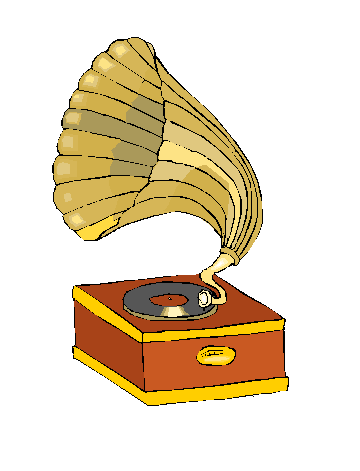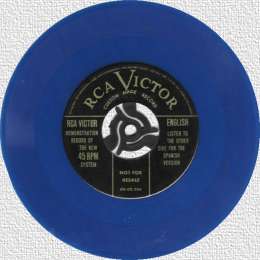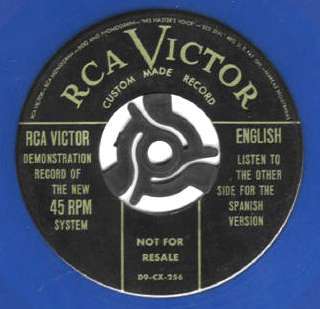A History of the Gramophone Record
 The first records were on cylinders,
the earliest of which were made by the inventor of the first
'Phonograph', Thomas Alva Edison in 1877. Attempts had been made
of 'recording' sound much earlier than this, but none were capable
of reproducing the human voice.
The first records were on cylinders,
the earliest of which were made by the inventor of the first
'Phonograph', Thomas Alva Edison in 1877. Attempts had been made
of 'recording' sound much earlier than this, but none were capable
of reproducing the human voice.
By 1887, another American, Emile Berliner (a German immigrant to the U.S.) filed a patent for a recording system based on a flat disc instead of a cylinder. This was a very significant development because the new discs were much easier to mass produce than the cylinders that they replaced. This was important in making the technology available to a wide market.
By the turn of the century the industry had begun to settle on a diameter of 10 inches for the new format. The rotational speed varied somewhat from one manufacturer to another, but most turned at between 75 and 80 revolutions per minute and most 'Gramophone' machines were capable of some adjustment. The name 'Gramophone' began as a Trademark for Berliner's new invention, but Europeans adopted it as generic while Americans continued to use the term 'Phonograph'. One popular theory for the choice of 78 rpm is arrived at from calculations based on the rotational speed of synchronous electric motors and achievable gear ratios. This is neither technically sound nor supported by historic evidence. It is far more likely that a speed of around 78 rpm simply proved the best compromise from empirical results with the materials and technology available at the time.
Various materials were used for manufacturing the earliest discs, but shellac (a resin made from the secretions of the lac insect) was found to be the best. Shellac is a natural thermoplastic, being soft and flowing when heated, but rigid and hard wearing at room temperature. Usually a fine clay or other filler was added to the 'mix'. However, by the 1930s the natural shellac began to be replaced by equivalent synthetic resins.
All of the earliest 78 rpm recordings were single sided, but double sided recordings were introduced firstly in Europe by the Columbia company. By 1923, double sided recordings had become the norm on both sides of the Atlantic.
The 78 rpm disc reigned supreme as the accepted recording medium for many years despite its tendency to break easily and the fact that longer works could not be listened to without breaks for disc changes (at 5 minute intervals for 12" discs).
In 1948 the Columbia company had perfected the 12" Long Playing Vinyl disc. Spinning at 33 rpm the new format could play up to 25 minutes per side. This new record medium also had a much lower level of surface noise than did its older shellac cousin. However, Columbia's big rival, RCA Victor then produced the seven inch 45 rpm vinyl disc. These could hold as much sound as the 12" 78 rpm discs they were to replace, but were much smaller and attractive.
 |
Here is what RCA Victor's original 45 looked like. This image was kindly supplied by Jules Woodell who manages the Record Collector's Glossary Note the large centre hole which needs an adaptor to make it fit a regular UK style spindle was already a feature and that coloured vinyl was not such a novelty in the 1940s!
|
 |
|
It took many years for the 78 to disappear because the new vinyl records needed new equipment on which to play them, but the two new vinyl formats then were to dominate the recorded music industry until the advent of the digital compact disc (CD). Even then, vinyl would take much longer to fall into oblivion than 78s did when vinyl recordings first appeared.
The 45rpm record's years of greatest success began with the onset of rock and roll. The new 7 inch format was favoured by the young and in the UK sales of 45s overtook 78s early in 1958 as rock and roll established a boom in record sales.During the next few years the UK was to become a major source of popular recorded music with the advent of the British 'beat' groups which were exemplified in the 'Beatles'. This was the 'golden era' for the 45. Although sales of popular music were to grow dramatically during the following decades, buyers gradually transferred their purchases to the 12" 'LP' as their affluence grew. Indeed, by the end of the 1960s sales of the 45 had even begun to decline. During the early years of the Beatles, a record would need to sell in excess of 750,000 copies to reach the coveted number 1 chart position. Such was the decline in this part of the market that by a decade later only 150,000 copies could achieve the same result. (See 'EMI: The First 100 Years' by Peter Martland ISBN 0-7134-6207-8 Published by B.T.Batsford Ltd, London)

